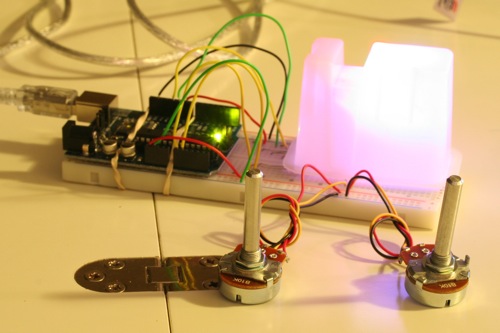Description
Two pots control three LEDs. LEDs blink in a syncopated rhythm, and the
pots control brightness and rhythm speed. One drawback is that pot
input only takes affect after the beat has completed.
Components Used
- LEDs
- Potentiometers
- Resistors
Arduino Code
/*
LightBeat
Two pots control three LEDs. LEDs blink in a syncopated rhythm, and the
pots control brightness and rhythm speed. One drawback is that pot
input only takes affect after the beat has completed.
By Ken-ichi Ueda
*/
int pinR = 9;
int pinG = 10;
int pinB = 11;
int pins[] = {pinR, pinG, pinB};
int potA = 0;
int potB = 1;
int valA = 0; // brightness
int valB = 0; // rhythm speed
int i = 0; // loop counter
int minWait = 100;
int maxWait = 1000;
int fadeT = 5;
//int actPinIndex = 0; // active pin in the rhythm
int actPin = pinR;
int const meter = 9;
float rhythm[9] = {1, 1, 2, 1.5, 0.5, 0.5, 1, 0.25, 0.25};int sequence[9] = {pinR, pinR, pinB, pinR, pinR, pinB, pinR, pinG, pinG};
int DEBUG = 1;
void setup() {
pinMode(pinR, OUTPUT);
pinMode(pinG, OUTPUT);
pinMode(pinB, OUTPUT);
Serial.begin(9600);
}
void loop() {
valA = analogRead(potA) / 4;
valB = (int) (((float) analogRead(potB) / 1024.0) * (maxWait - minWait)) + minWait;
for(i=0; i < meter; i++) { actPin = sequence[i];
if (DEBUG) { Serial.print("Setting pin "); Serial.print(actPin);
Serial.print(" to "); Serial.println(valA);
}
analogWrite(actPin, valA);
if (DEBUG) { Serial.print("Waiting "); Serial.print(valB);
Serial.println(" ms"); }
delay(valB * rhythm[i]);
analogWrite(actPin, 0);
delay(valB * rhythm[i] / 2);
}
}
Picture



Comments
it's not a drawback, it's a
it's not a drawback, it's a design feature :)